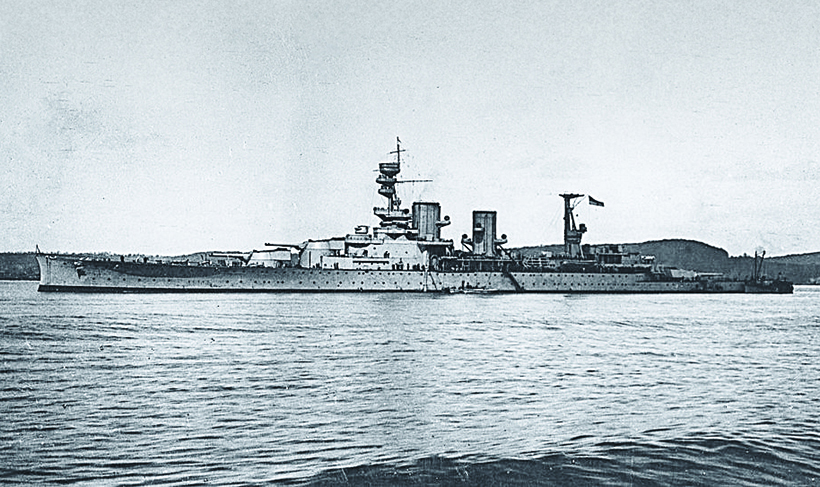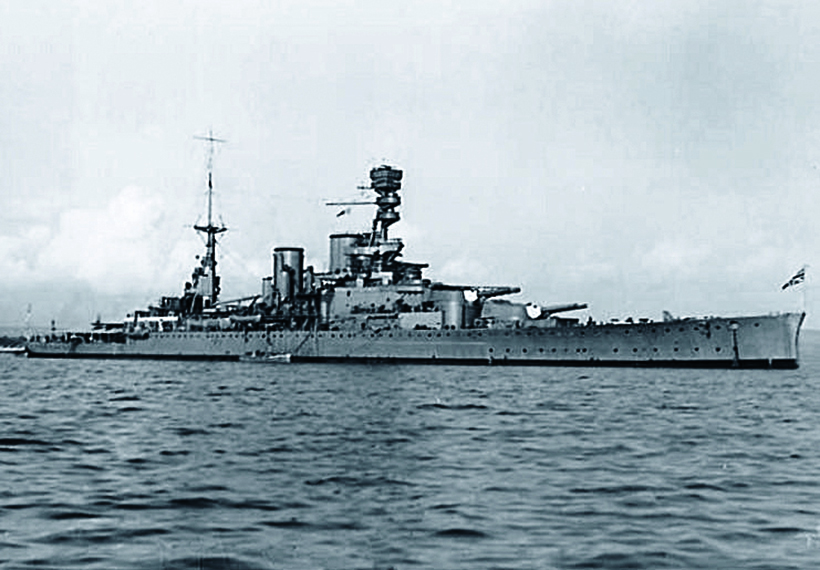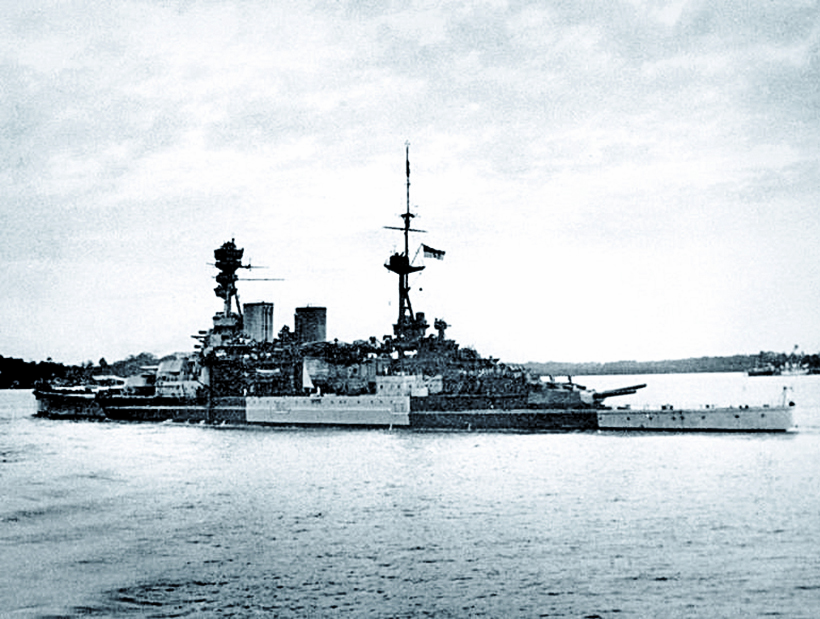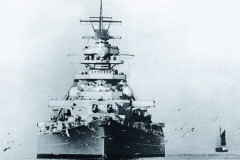BATTLECRUISER HMS REPULSE
Posted by Chris Graham on 16th February 2020
Trevor Piper recounts the service and eventual loss of the battlecruiser HMS Repulse, following the ill-conceived formation of Force Z
Winston Churchill’s government thought that the formation of a balanced naval force sent to Singapore, would limit further Japanese aggression. So, it was decided that the relatively new battleship HMS Prince of Wales, the old battlecruiser HMS Repulse and the new carrier, HMS Indomitable, would form the nucleus of the force. But in the event, HMS Indomitable ran aground while on shake-down trials in the West Indies, and the subsequent repairs prevented her from sailing East.
This grounding deprived the force of organic air cover, which was to prove disastrous for the other two capital ships, both of which were sunk by Japanese bombers off Malaya, on December 10th, 1941. This is the story of one of those ships, the battlecruiser, HMS Repulse.

The battlecruiser HMS Repulse sails up the River Clyde to her builders at Clydebank, for defect rectification after one of her early sea trials. Despite the urgency to complete the ship, there is still a fair amount of finishing to be carried out.
Basic design
Two battlecruisers, HMS Renown and her sister, HMS Repulse, were originally laid down as ‘R’ Class battleships for the 1914-1915 building programme, but were later cancelled as it was thought that they couldn’t be completed in time to take part in the war. After the success of the battlecruisers in the battle of the Falkland Islands, Admiral Lord Fisher obtained permission to have Renown and Repulse completed as battlecruisers within 15 months of being laid down. HMS Repulse was originally scheduled to be built by Palmers on the Tyne, but Palmers didn’t have a long enough slip to build the ship, so construction was moved to John Brown’s Clydebank yard.
Work on the new design was initiated on December 19th, 1914, it was approved on April 22nd, 1915, although sufficient detail had been delivered to the builders in January 1915 for work to commence. The great ship was launched just one year later, on January 8th,1916, and completed just seven months later in August, 1916. As originally designed, the 26,854-ton ship was 789ft long, with a beam of 90ft and a draught of 26ft.
Its main armament consisted of three twin turrets mounting 15in Mk 1 guns, with two turrets forward and one aft. The guns could elevate 20 degrees, and had a range of 24,000 yards. Although only six guns were fitted, the main armament was considered satisfactory, but the secondary armament was regarded as being poor, with 17 4in guns, of which 15 were in the clumsy, triple mount. Only two, 3in anti-aircraft guns were fitted.

The newly-completed HMS Repulse at anchor in the River Clyde, after her initial speed trials in August 1916, during which she achieved 32knots over the measured mile.
The battlecruiser was also equipped with two, 21in torpedo tubes fitted in the hull, either side below ‘A’ turret. To avoid a delay in designing new machinery, a virtually identical installation of that from the earlier battlecruiser HMS Tiger, was duplicated. Power was provided by 42 Babcock and Wilcox boilers in six boiler rooms, which provided steam to the Brown Curtiss turbines developing 120,000shp for the four propeller shafts. During trials on the measured mile, HMS Repulse attained 32 knots.
Given the rush to completion, when she arrived for service with the Grand Fleet as Flagship of the No.1 Battlecruiser Squadron, the armour protection was considered to be somewhat inadequate. Consequently, Admiral Jellico demanded that additional armour protection was fitted, and the ship was taken in hand by her builders at Rosyth dockyard (between November 1916 and January 1917) for an additional 500 tons of armour to be fitted on the armoured deck, over the engine rooms and magazine crowns. Displacement increased to 27,420 tons.
Initial service
HMS Repulse was first in action during the second Battle of Heligoland Bight, on November 17th, 1917, where she initially engaged two German battleships – SMS Kaiser and SMS Kaiserin. During the battle, she fired 54 main armament rounds, but only scored one hit on the light cruiser Konigsberg. The next month the ship collided with the Australian Battlecruiser HMAS Australia, with the latter requiring several weeks-worth of repairs before she was operational again.
At the end of the war, HMS Repulse was taken in hand at Portsmouth Dockyard, for an extensive refit during which an additional 6,000 tons of armour protection was added, and the torpedo bulges were modified. The peace time working conditions meant the refit wasn’t completed until April 1922. The ship then deployed to the Mediterranean for exercises, before being selected to attend the Brazilian Centenary celebrations, with HMS Hood, at Rio de Janeiro. Service with the Atlantic Fleet followed for most of 1923, with the Battlecruiser Squadron, before Repulse began preparations for the world tour by the Prince of Wales, to the British Empire.

An inter-war image of HMS Repulse firing a 15in broadside during exercises in September 1929. The unsuccessful, triple 4in gun mounts are shown to good affect, either side of the bridgework.
Empire tour
During this deployment, the ship sailed around the world, calling first at Freetown, then Capetown and Zanzibar, before arriving at Freemantle on January 17th, 1924, where she stayed for one week. After the usual warm, Australian welcome, the next port of call was Albany, followed by Adelaide and Melbourne. A further port call was made to Hobart Tazmania, before the ship arrived at Sydney on April 9th, 1924, where she stayed for 11 days. This was followed by departure for Wellington, NZ, and Repulse left here on May 7th for the long haul across the Pacific to Vancouver, via the islands of Suva, Samara, Fiji, Apia and W Samoa, reaching Canada on July 6th.
Together with HMS Hood, the Repulse called at ports along the western coast of the USA, before transiting the Panama Canal and arriving back at Portsmouth on September 29th. During the cruise, the ship steamed over 30,000 miles. The battlecruiser rejoined the Atlantic Fleet in October, but was again selected in December to undertake another Royal Tour with the Prince of Wales, this time to Portugal, South Africa and the East coast of South America. The ship didn’t resume her duties with the Atlantic Fleet until 1926. The next six years were a relatively peaceful period, during which the ship deployed regularly with the Atlantic Fleet, interposed with exercises in the Mediterranean.
Major refit
By late 1932, Repulse was badly in need of a refit and modernisation, so she was taken in hand in early 1933, for a three-year work package which included the installation of yet more armour protection, a complete overhaul of the machinery, upgrading of the accommodation mess-decks, fitting of additional anti-aircraft guns and an aircraft catapult with two hangers. On completion of the work, the ship re-commissioned for service with the Mediterranean Fleet, under the command of Captain John Godfrey RN and, in June 1937, took part in the Spanish War neutrality patrols, being involved in negotiating the release of a British merchant ship stopped by the Spanish cruiser Miguel Cervantes.
Early 1938 saw the ship transfer to the Home Fleet, before beginning yet another refit in October as the she had been selected to convey HM King George VI and the Queen for a Royal tour to Canada. In the event, the use of a major warship as a Royal Yacht was ruled out, due to the increased tension with Germany. The Canadian Pacific Liner, Empress of Australia, was chartered to convey the royal party for the tour. After acting as an escort for the liner, HMS Repulse redeployed to the Home Fleet 1st Battle Squadron alongside HMS Hood, and her newly-modernised sister, HMS Renown.
Second World War
At the outbreak of the war, the Battlecruiser Squadron was engaged on convoy escort duties in the North-west approaches, and also into the North Sea, to deter commerce raiders and merchant vessels trying to return home to Germany. In October, HMS Repulse was off Norway carrying out an unsuccessful search for the battlecruiser Gneisenau, and the cruiser Koln. The weather during this operation was extremely poor with raging gales, and the ship had to return to Scapa Flow to repair damage to her forward break water.
In November, the vessel provided cover for convoy HX to Halifax, Canada, but left Halifax almost immediately in company with the carrier Furious, to search for the German battlecruisers Scharnhorst and Gneisenau after they’d sunk the armed merchant cruiser, Rawalpindi. The German ships were not found, which is just as well as the outdated Repulse would have been severely mauled by the two modern and sharp-shooting German battlecruisers. Further Atlantic convoy escort duties followed, and the ship was lucky to escape damage when, while in company with HMS Barham, the battleship was torpedoed and seriously damaged by U-30.
In January, HMS Repulse joined with the battleships HMS Nelson and HMS Rodney in a sweep into the Norwegian Sea, in search of German warships, before resuming convoy escort duties. In early April, the abortive British adventure in Norway was in full swing, and HMS Repulse provided cover until she returned to Scapa Flow on the 18th. The ship then covered the British withdrawal from Norway, before beginning yet another fruitless search in the Atlantic, with her sister HMS Renown, for the battlecruiser Gneisenau.
The remainder of 1940, saw the ship swinging on a buoy in Scapa Flow, or on Atlantic escort duties. During this period, the ship joined forces with HMS Hood and HMS Renown in trying to track down the German pocket battleship Admiral Scheer, which had broken out into the Atlantic, and had sunk the armed merchant cruiser, Jervis Bay. More Atlantic escort duty followed, with the ship being almost continuously at sea before a return to warmer climates saw it escort convoy WS8A to Gibraltar in early May, before returning to Scapa Flow.
The battlecruiser sailed on May 23rd in company with the Home Fleet Flagship, HMS King George V, and the newly-commissioned carrier, HMS Victorious, to intercept the battleship Bismarck. After the loss of HMS Hood, the Admiralty was loath to put the aging battlecruiser in the line of fire against the formidable German ship and, in the event, a lack of fuel meant Repulse had to be detached to Newfoundland to refuel, thus missing the final action. In August, HMS Repulse was selected to be a unit of the newly forming Force Z, to deploy to the Far East, and the ship entered HM Dockyard Rosyth for an overhaul, and the fitting of a new main armament fire control radar set.
The destruction of Force Z
In September, the great ship left UK waters for what turned out to be the last time, and sailed via Freetown in company with convoy WS11 to Durban, arriving in South Africa on October 8th. During the subsequent voyage to Columbo, a new type 286 air search radar set was installed by the ship’s engineers. At Columbo, the Force Z flagship, HMS Prince of Wales (flying the flag of Admiral Sir Tom Phillips; newly appointed after a long period as a staff officer at the UK Admiralty), joined the force and they subsequently sailed on to Singapore, with HMS Repulse anchoring in the roadstead, off the naval base, on December 2nd.
The ship left Singapore three days later to visit Darwin, but was recalled to Singapore on the 6th after aircraft had sighted Japanese troop transports in the Gulf of Siam. On the 8th, despite the lack of organic air cover and the RAF being overstretched and unable to help, Admiral Philips sailed Force Z from Singapore in a sweep up the Eastern Malay coast, hoping to attack the Japanese troop transports. He reasoned that Japanese aircraft could not operate so far from land, and that his capital ships would be immune from fatal damage as, so far in the war, no capital ship had been sunk at sea by air attack. It was to prove a fatal assumption.

The battlecruiser sails from Singapore in company with HMS Prince of Wales on December 8th, 1941, never to return. Force Z was en-route to attack Japanese transport ships in the Gulf of Siam, when it was attacked by Japanese aircraft.
By the 10th, Force Z had failed to find the Japanese transport ships, and turned south heading back to Singapore. But they were spotted by a Japanese aircraft, then attacked by 86 aircraft of the 22nd Air Flotilla, based in Saigon. The Prince of Wales was disabled early on in the attack, with hits on her propeller shafts, but Captain Tennant fought his aging ship well and exercised superb seamanship as he successfully evaded countless torpedo attacks. He handled his large ship more like a destroyer than a battlecruiser, and combed the first wave of torpedo attacks before the ship was caught by a skilful synchronised pincer attack. It was hit by at least four or five torpedoes in quick succession.
HMS Repulse was fatally hit and developed a severe list to port in just six minutes. Captain Tenant realised that his ship was lost and the crew abandoned ship as the ship rolled over and sank at 12.23. Although much older than the Flagship, the Repulse had survived a bomb hit, and avoided 19 torpedoes, before being sunk.
The end when it came was quick, but 1,285 of the ship’s company were rescued by the destroyers HMS Electra and HMAS Vampire. The ship lies on her side’ with the nearest side just 100ft down, and can be seen as a shadow on a clear day when flying over. The wreck of HMS Repulse was designated a ‘Protected Place’ in 2001, under the Protection of Military Remains act 1986. The Royal Navy continues to maintain a White Ensign flag on the mast of the ship.
To subscribe to World of Warships, click here





